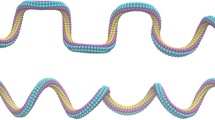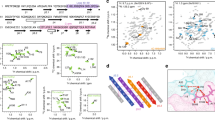Abstract
Beta-solenoids are a class of protein nanotube structures that are observed in virulence factors, prion proteins and amyloid fibrils. Here we investigate the compressive strength of the triple-beta-helix solenoid structure found in the cell puncture needle of the bacteriophage T4 virus. We characterize the compressive mechanical strength of this protein nanotube using full-atomistic molecular dynamics simulations in explicit solvent over a wide range of deformation speeds. We observe that the dynamical behavior, stiffness and failure strength of the structure are strongly dependent on the deformation rate. We illustrate that H-bond rupture initiation is the atomistic mechanism that leads to instability and buckling of the protein nanotube at the peak force. We show that the behavior of the protein under small compressive deformation can be approximated by a rate-dependent linear elastic modulus, which can be used in context of a continuum Euler buckling formula for the triple-helix geometry to predict the failure load. Our work provides a link between the structure and biofunctional properties of this beta-solenoid topology, and illustrates a rigorous framework for bridging the gap between experimental and simulation time-scales for future compression studies on proteins. Our study is relevant to self-assembling peptide nanotube materials, and may provide insight into the influence of mechanical properties on the pathological pathways of virulence factors, prions and amyloids found in neurodegenerative diseases.





Similar content being viewed by others
References
Ackbarow, T., et al. (2007). Hierarchies, multiple energy barriers, and robustness govern the fracture mechanics of alpha-helical and beta-sheet protein domains. Proc Natl Acad Sci USA 104(42):16410–16415.
Bernstein, F.C., et al., The Protein Data Bank: computer-based archival file for macromolecular structures. J. Mol. Biol., 1977. 112(3): p. 535–542.
Brändén, C.-I., and J. Tooze, Introduction to Protein Structure, 2nd ed. New York: Garland Publishing, xiv, 410 pp, 1999
Buehler, M. J., Nature designs tough collagen: explaining the nanostructure of collagen fibrils. Proc. Natl. Acad. Sci. USA, 2006. 103(33): p. 12285–12290.
Buehler, M. and S. Wong, Entropic elasticity controls nanomechanics of single tropocollagen molecules. Biophys. J., 2007. 93(1): p. 37–43.
Buschmann, M.D. and A.J. Grodzinsky, A molecular-model of proteoglycan-associated electrostatic forces in cartilage mechanics. J. Biomech. Eng. Trans. ASME, 1995. 117(2): p. 179–192.
Chiti, F. and C.M. Dobson, Protein misfolding, functional amyloid, and human disease. Annu. Rev. Biochem., 2006. 75: p. 333–366.
Cox, D.L., et al., The materials science of protein aggregation. MRS Bull., 2005. 30(6): p. 452–457.
da Silva, A. and O. Teschke, Dynamics of the antimicrobial peptide PGLa action on Escherichia coli monitored by atomic force microscopy. World J. Microbiol. Biotechnol., 2005. 21(6–7): p. 1103–1110.
Gittes, F., et al., Flexural rigidity of microtubules and actin-filaments measured from thermal fluctuations in shape. J. Cell Biol., 1993. 120(4): p. 923–934.
Govaerts, C., et al., Evidence for assembly of prions with left-handed beta 3-helices into trimers. Proc. Natl. Acad. Sci. USA, 2004. 101(22): p. 8342–8347.
Graether, S., et al., beta-helix structure and ice-binding properties of a hyperactive antifreeze protein from an insect. NATURE, 2000. 406(6793): p. 325–328.
Hansma, H. G., et al., Probing biopolymers with the atomic force microscope: A review. J. Biomater. Sci. Polym. Ed., 2000. 11(7): p. 675–683.
Hibbeler, R.C., Statics and Mechanics of Materials. 2 ed. 2005, Englewood Cliffs, NJ: Prentice Hall. 800.
Humphrey, W., A. Dalke, and K. Schulten (1996) VMD: visual molecular dynamics. J Mol Graph 14(1):33–38.
Isralewitz, B., M. Gao, and K. Schulten, Steered molecular dynamics and mechanical functions of proteins. Curr. Opin. Struct. Biol., 2001. 11(2): p. 224–230.
Kajava, A., J. Squire, and D. Parry (2006) Beta-structures in fibrous proteins. Adv Protein Chem 73:1–15.
Kanamaru, S., et al., Structure of the cell-puncturing device of bacteriophage T4. Nature, 2002. 415(6871): p. 553–557.
Kellermayer, M.S.Z., et al., Reversible mechanical unzipping of amyloid beta-fibrils. J. Biol. Chem., 2005. 280(9): p. 8464–8470.
Keten, S. and M.J. Buehler, Large deformation and fracture mechanics of a beta-helical protein nanotube: Atomistic and continuum modeling. Comput. Methods Appl. Mech. Eng., 2008. 197(41–42): p. 3203–3214.
Keten, S. and M.J. Buehler, Geometric confinement governs the rupture strength of H-bond assemblies at a critical length scale. Nano Lett., 2008. 8(2): p. 743–748.
27. Keten, S., and M. J. Buehler (2008) Asymptotic strength limit of hydrogen bond assemblies in proteins at vanishing pulling rates. Phys Rev Lett 100(19):198301.
Kishimoto, A., et al., beta-Helix is a likely core structure of yeast prion Sup35 amyloid fibers. Biochem. Biophys. Res. Commun. 2004. 315(3): p. 739–745.
Knowles, T.P., et al., Role of intermolecular forces in defining material properties of protein nanofibrils. Science, 2007. 318(5858): p. 1900–1903.
MacKerell, A.D., et al., All-atom empirical potential for molecular modeling and dynamics studies of proteins. J. Phys. Chem. B, 1998. 102(18): p. 3586–3616.
Marszalek, P.E., et al., Mechanical unfolding intermediates in titin modules. Nature, 1999. 402(6757): p. 100–103.
Mitraki, A., S. Miller, and M.J. van Raaij, Review: Conformation and folding of novel beta-structural elements in viral fiber proteins: the triple beta-spiral and triple beta-helix. J. Struct. Biol., 2002. 137(1–2): p. 236–247.
Mostaert, A. S., and S. P. Jarvis (2007). Beneficial characteristics of mechanically functional amyloid fibrils evolutionarily preserved in natural adhesives. Nanotechnology 18(4):044010.
Mucke, N., et al., Assessing the flexibility of intermediate filaments by atomic force microscopy. J. Mol. Biol., 2004. 335(5): p. 1241–1250.
Nelson, M.T., et al., NAMD: A parallel, object oriented molecular dynamics program. Int. J. Supercomput. Appl. High Perform. Comput., 1996. 10(4): p. 251–268.
Oroudjev, E., et al., Segmented nanofibers of spider dragline silk: Atomic force microscopy and single-molecule force spectroscopy. Proceedings of the National Academy of Sciences, 2002. 99(Suppl 2): p. 6460–6465.
Rief, M., et al., Reversible unfolding of individual titin immunoglobulin domains by AFM. Science, 1997. 276(5315): p. 1109–1112.
Rief, M., et al., The mechanical stability of immunoglobulin and fibronectin III domains in the muscle protein titin measured by atomic force microscopy. Biophys. J., 1998. 75(6): p. 3008–3014.
Ritter, C., et al., Correlation of structural elements and infectivity of the HET-s prion. Nature, 2005. 435(7043): p. 844–848.
Smith, J.F., et al., Characterization of the nanoscale properties of individual amyloid fibrils. Proc. Natl. Acad. Sci. USA, 2006. 103(43): p. 15806–15811.
Sotomayor, M. and K. Schulten, Single-molecule experiments in vitro and in silico. Science, 2007. 316(5828): p. 1144–1148.
Sun, Y.L., et al., Direct quantification of the flexibility of type I collagen monomer. Biochem. Biophys. Res. Commun., 2002. 295(2): p. 382–386.
Wasmer, C., et al., Amyloid fibrils of the HET-s(218–289) prion form a beta solenoid with a triangular hydrophobic core. SCIENCE, 2008. 319(5869): p. 1523–1526.
Yoder, M.D., S.E. Lietzke, and F. Jurnak, Unusual Structural Features in the Parallel Beta-Helix in Pectate Lyases. Structure, 1993. 1(4): p. 241–251.
Acknowledgments
This research was supported by the Office of Naval Research (Grant No.: N000140810844). The authors acknowledge a supercomputing grant at the San Diego Supercomputing Center (SDSC), as well as a large-scale computation grant from NSF TeraGrid system (Grant No.: MSS080030). The authors acknowledge helpful discussions with Prof. Matt Lang. J.F.R.A. acknowledges support from the Undergraduate Research Opportunities Program Office at MIT through the Paul E. Gray (1954) Endowed Fund for UROP.
Author information
Authors and Affiliations
Corresponding author
Rights and permissions
About this article
Cite this article
Keten, S., Rodriguez Alvarado, J.F., Müftü, S. et al. Nanomechanical Characterization of the Triple β-Helix Domain in the Cell Puncture Needle of Bacteriophage T4 Virus. Cel. Mol. Bioeng. 2, 66–74 (2009). https://doi.org/10.1007/s12195-009-0047-9
Received:
Accepted:
Published:
Issue Date:
DOI: https://doi.org/10.1007/s12195-009-0047-9




